Christopher S. Bretherton
ACE2: Accurately learning subseasonal to decadal atmospheric variability and forced responses
Nov 18, 2024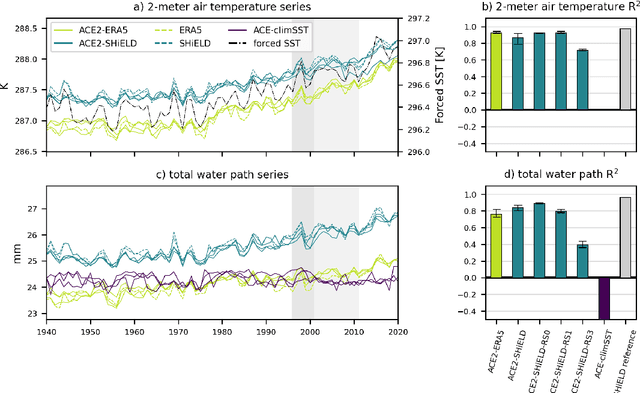

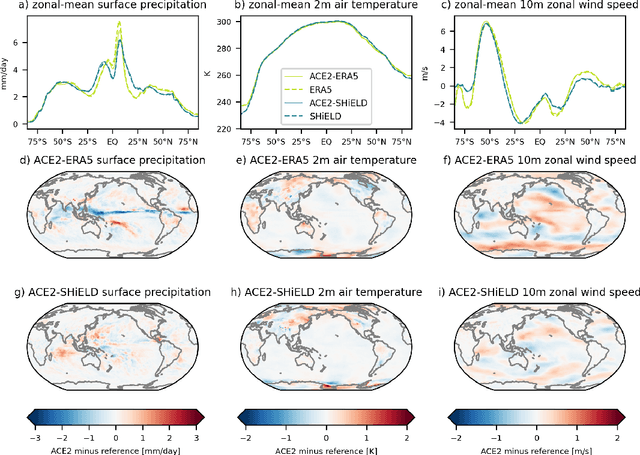

Abstract:Existing machine learning models of weather variability are not formulated to enable assessment of their response to varying external boundary conditions such as sea surface temperature and greenhouse gases. Here we present ACE2 (Ai2 Climate Emulator version 2) and its application to reproducing atmospheric variability over the past 80 years on timescales from days to decades. ACE2 is a 450M-parameter autoregressive machine learning emulator, operating with 6-hour temporal resolution, 1{\deg} horizontal resolution and eight vertical layers. It exactly conserves global dry air mass and moisture and can be stepped forward stably for arbitrarily many steps with a throughput of about 1500 simulated years per wall clock day. ACE2 generates emergent phenomena such as tropical cyclones, the Madden Julian Oscillation, and sudden stratospheric warmings. Furthermore, it accurately reproduces the atmospheric response to El Ni\~no variability and global trends of temperature over the past 80 years. However, its sensitivities to separately changing sea surface temperature and carbon dioxide are not entirely realistic.
Probabilistic Emulation of a Global Climate Model with Spherical DYffusion
Jun 21, 2024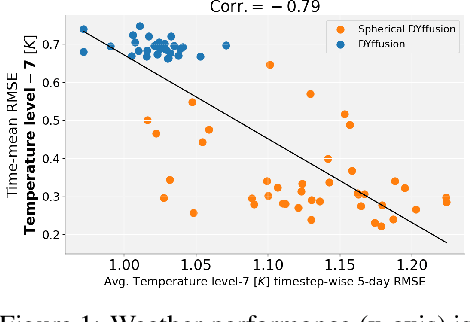
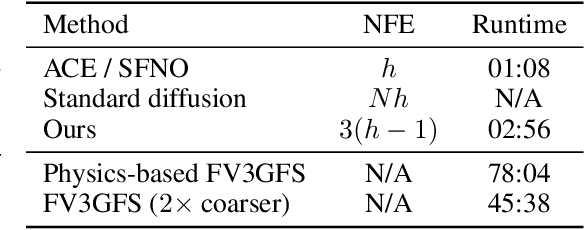

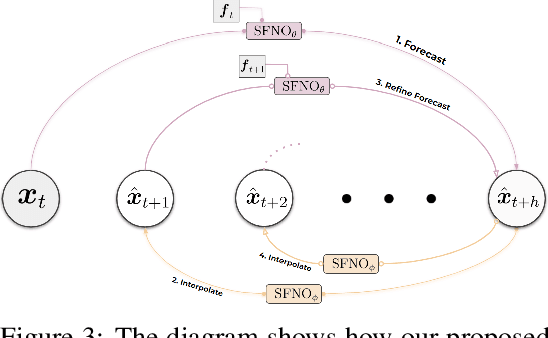
Abstract:Data-driven deep learning models are on the verge of transforming global weather forecasting. It is an open question if this success can extend to climate modeling, where long inference rollouts and data complexity pose significant challenges. Here, we present the first conditional generative model able to produce global climate ensemble simulations that are accurate and physically consistent. Our model runs at 6-hourly time steps and is shown to be stable for 10-year-long simulations. Our approach beats relevant baselines and nearly reaches a gold standard for successful climate model emulation. We discuss the key design choices behind our dynamics-informed diffusion model-based approach which enables this significant step towards efficient, data-driven climate simulations that can help us better understand the Earth and adapt to a changing climate.
ACE: A fast, skillful learned global atmospheric model for climate prediction
Oct 03, 2023
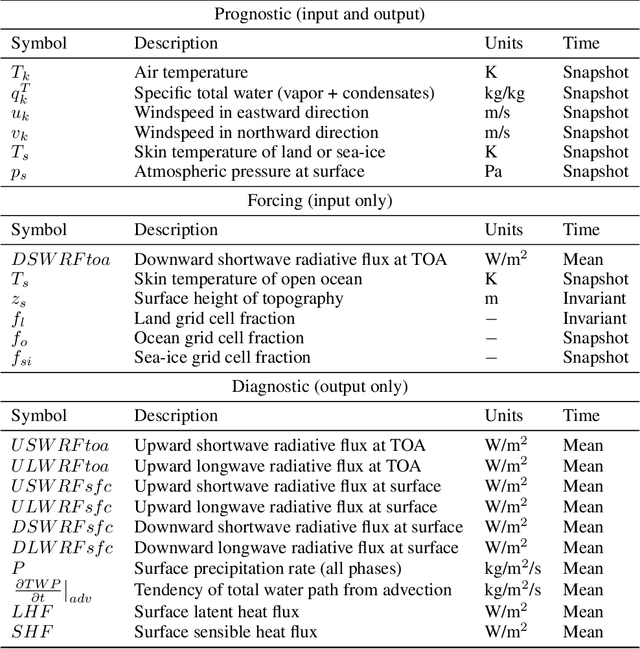


Abstract:Existing ML-based atmospheric models are not suitable for climate prediction, which requires long-term stability and physical consistency. We present ACE (AI2 Climate Emulator), a 200M-parameter, autoregressive machine learning emulator of an existing comprehensive 100-km resolution global atmospheric model. The formulation of ACE allows evaluation of physical laws such as the conservation of mass and moisture. The emulator is stable for 10 years, nearly conserves column moisture without explicit constraints and faithfully reproduces the reference model's climate, outperforming a challenging baseline on over 80% of tracked variables. ACE requires nearly 100x less wall clock time and is 100x more energy efficient than the reference model using typically available resources.
ClimSim: An open large-scale dataset for training high-resolution physics emulators in hybrid multi-scale climate simulators
Jun 16, 2023Abstract:Modern climate projections lack adequate spatial and temporal resolution due to computational constraints. A consequence is inaccurate and imprecise prediction of critical processes such as storms. Hybrid methods that combine physics with machine learning (ML) have introduced a new generation of higher fidelity climate simulators that can sidestep Moore's Law by outsourcing compute-hungry, short, high-resolution simulations to ML emulators. However, this hybrid ML-physics simulation approach requires domain-specific treatment and has been inaccessible to ML experts because of lack of training data and relevant, easy-to-use workflows. We present ClimSim, the largest-ever dataset designed for hybrid ML-physics research. It comprises multi-scale climate simulations, developed by a consortium of climate scientists and ML researchers. It consists of 5.7 billion pairs of multivariate input and output vectors that isolate the influence of locally-nested, high-resolution, high-fidelity physics on a host climate simulator's macro-scale physical state. The dataset is global in coverage, spans multiple years at high sampling frequency, and is designed such that resulting emulators are compatible with downstream coupling into operational climate simulators. We implement a range of deterministic and stochastic regression baselines to highlight the ML challenges and their scoring. The data (https://huggingface.co/datasets/LEAP/ClimSim_high-res) and code (https://leap-stc.github.io/ClimSim) are released openly to support the development of hybrid ML-physics and high-fidelity climate simulations for the benefit of science and society.
Machine-learned climate model corrections from a global storm-resolving model
Nov 21, 2022Abstract:Due to computational constraints, running global climate models (GCMs) for many years requires a lower spatial grid resolution (${\gtrsim}50$ km) than is optimal for accurately resolving important physical processes. Such processes are approximated in GCMs via subgrid parameterizations, which contribute significantly to the uncertainty in GCM predictions. One approach to improving the accuracy of a coarse-grid global climate model is to add machine-learned state-dependent corrections at each simulation timestep, such that the climate model evolves more like a high-resolution global storm-resolving model (GSRM). We train neural networks to learn the state-dependent temperature, humidity, and radiative flux corrections needed to nudge a 200 km coarse-grid climate model to the evolution of a 3~km fine-grid GSRM. When these corrective ML models are coupled to a year-long coarse-grid climate simulation, the time-mean spatial pattern errors are reduced by 6-25% for land surface temperature and 9-25% for land surface precipitation with respect to a no-ML baseline simulation. The ML-corrected simulations develop other biases in climate and circulation that differ from, but have comparable amplitude to, the baseline simulation.
 Add to Chrome
Add to Chrome Add to Firefox
Add to Firefox Add to Edge
Add to Edge